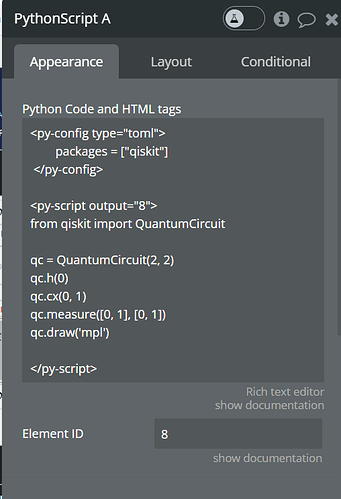Hello Zeroqode Community,
I’m currently working on a feature that aims to visualize quantum circuits directly in the browser. The idea is straightforward: users create a quantum circuit, and upon executing it by clicking “run circuit,” the circuit diagram is dynamically generated and displayed. The backend of this operation relies on Python code that imports and utilizes Qiskit for both the execution and the visualization of the quantum circuit.
To facilitate running Python in the browser, I’ve installed PyScript, following the setup guide available on Bubble.io’s PyScript Plugin Page. Despite adhering to the provided instructions and ensuring my settings match those recommended, the desired circuit visualization isn’t being rendered. Instead, I encounter the following error:
JsException(PythonError: Traceback (most recent call last): File "/lib/python3.10/site-packages/_pyodide/_base.py", line 429, in eval_code .run(globals, locals) File "/lib/python3.10/site-packages/_pyodide/_base.py", line 300, in run coroutine = eval(self.code, globals, locals) File "", line 1, in ModuleNotFoundError: No module named 'qiskit' )
The crux of the issue seems to be the inability to import the qiskit module. I’m seeking guidance on how to successfully integrate Qiskit within this PyScript setup. Is there an additional step or configuration needed to facilitate this, particularly with Pyodide’s package management?
Additionally, I am unsure how to reference specific element IDs within my Python code for PyScript. I’ve reviewed examples such as the TO-DO App Using PyScript but couldn’t pinpoint how element IDs are integrated. Any insights or examples on this would be incredibly helpful.
I appreciate any assistance, insights, or guidance you can provide to help overcome these hurdles. Your support will significantly contribute to advancing this project and enhancing our quantum computing educational tools.
Thank you in advance for your time and help!
Best regards,
Jonathan



